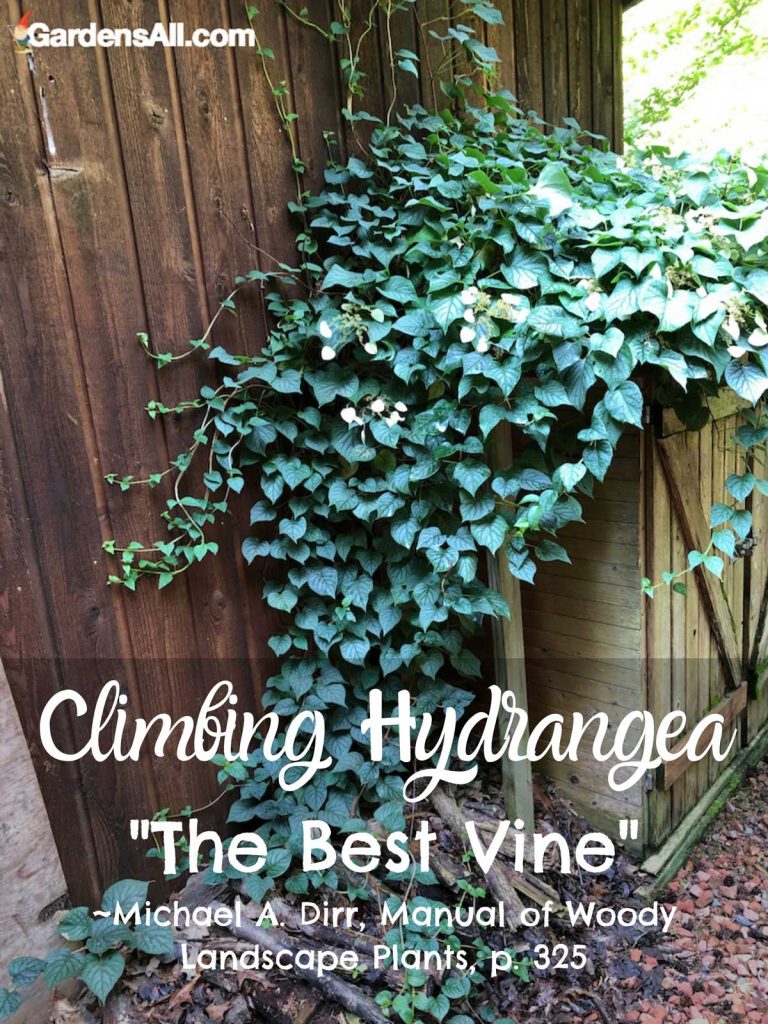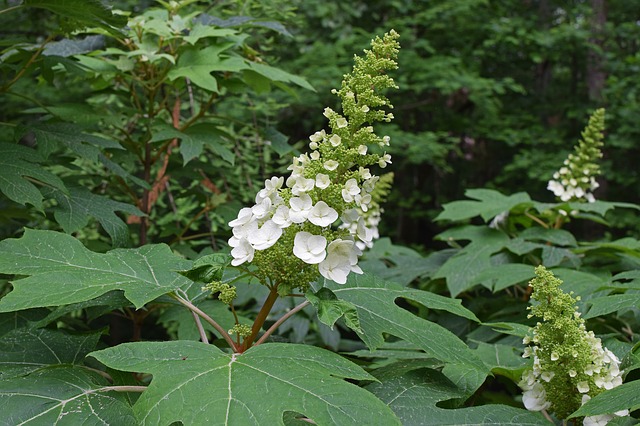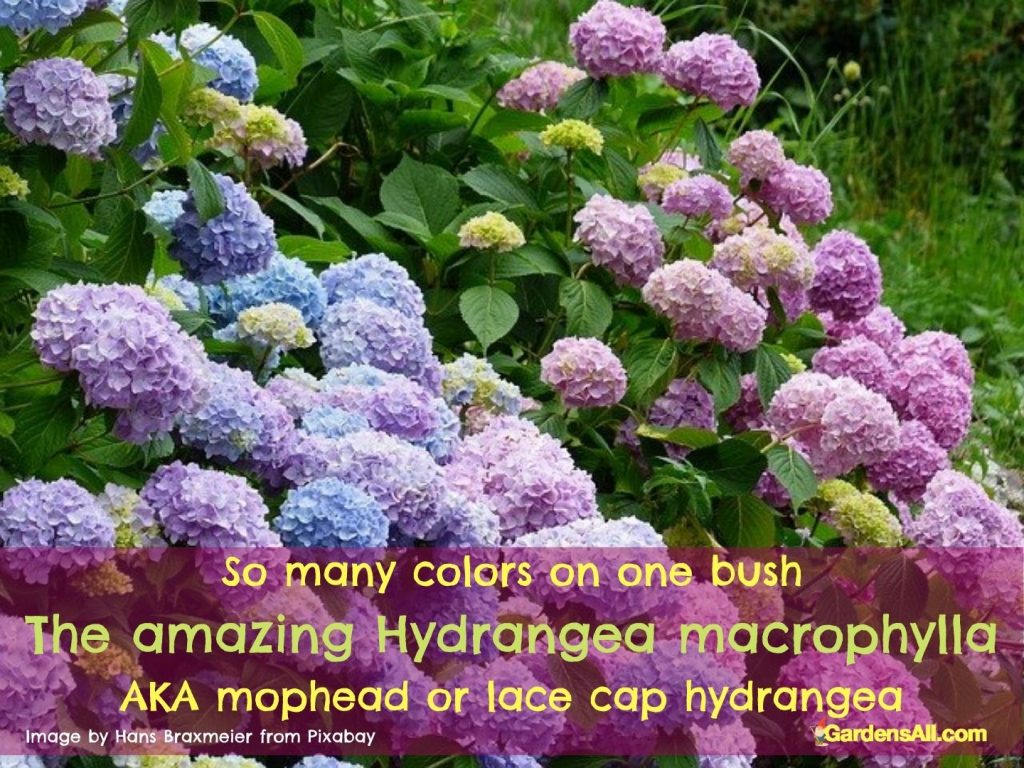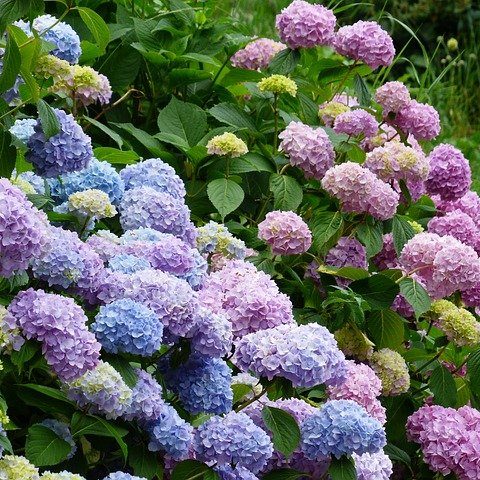Hydrangeas are one of our favorite flowering shrubs that lights up spring and summer landscapes. They come in a variety of sizes, shapes and, of course, colors. Since we’re in the woods, we’re naturally more focused on shade tolerant hydrangeas.
In this article we’re sharing the hydrangeas we’re growing as well as some general info on hydrangeas, including medicinal uses and benefits.
Hydrangeas
Scientific Name
Genus name [hydrangea] derives from hydro (water) and aggeion (vessel) due to the cup-like shape of the fruit. [1]https://www.missouribotanicalgarden.org/PlantFinder/PlantFinderDetails.aspx?taxonid=292385
- Family: Saxifragaceae
- Genus: hydrangea
- hydro (water)
- aggeion (vessel) (αγγείων)
- Common Names:
- lace cap
- mop head
- oak leaf
- climbing
- bigleaf
- French
- penny mac
- hortensia
!["Genus name [hydrangea] derives from hydro (water) and aggeion (vessel) due to the cup-like shape of the fruit." #garden #flower #landscaping #growing #planting #potted #climbing #bush #oakleaf #frontyard #indoor #outdoor #design #diy #leaves #decoration #arrangements #care #shade #perennials #colors #prunning #tips #ideas #gardening #cuttings #container #vase #bouquet #leaves](https://www.gardensall.com/wp-content/uploads/2019/06/Hydrangeas-names.jpg)
Our Sage Gnome (aka Wizard Gnome) watching over the GardensAll garden and creatures.
Hydrangea Uses in Landscape
Attractive to pollinators, hydrangeas can adorn the landscape as specimen plants, accents, or in mass plantings, such as foundation plants. They also work well as the tall backdrop bushes for lower growing mid to low plants such as hostas and flowers.
Many hydrangeas are shade tolerant, through perform best with a few hours of daily sun.
Tier Hydrangeas in Landscape Beds
- Back row – Hydrangeas – perennials
- Middle row – Hostas – perennials
- Front row – Flowers – annual or perennials
Landscaping with Hydrangeas Includes
- Showy backdrops in foundation landscaping
- Regal standalone shrubs
- Magnificent collections of hydrangea bushes
What Hydrangeas Blossom Colors Reveal
A fascinating aspect of many hydrangeas is that their blooms are like pH (soil acidity) barometers. Pinks appear in higher pH soils whereas the blues show in acidic soils.
White blossoms often indicate a neutral pH (6-7), unless it’s already a white variety of hydrangea, such as with the climbing and oak leaf varieties.
You Can Change Your Hydrangea Color
Moreover, growers can actually change the color of their hydrangeas by adjusting the pH. You can read more about that in this article on how to change hydrangea colors on our friend, Adriana’s website.
We’ve grown a number of varieties here in our shady woods garden (zone 7a). Here’s a quick rundown on the types we have in our landscape:
Oakleaf – Hydrangea quercifolia
Oak leaf flowers turn tan and persist into winter adding interest to the landscape.
🍃SIZE: Large plant (6-10 ft ht /spread 6 ft or wider)
🍃LEAF: Lobed (oak-like) leaves 3- 8 inches long and often 2/3’s as wide
🍃HABIT: Upright habit
🍃YEAR ROUND: Bark exfoliates; tan flowers add visual interest in winter
🍃DIFFICULTY: Basically trouble free
🍃FLOWERS: White flowers change to purplish/lavender then brown out
🍃GROWTH: Slow-medium grower
🍃ZONE: Hardy down to -10 (protect in Zone 5 or colder)
🍃SUN: – Shade tolerant – sun to partial shade

Oak Leaf Hydrangea Video
Lady in Red – Hydrangea macrophylla
🍃SIZE: Moderate size (5 ft ht by 3-5 ft w)
🍃LEAF: Red veined leaves borne on red stems
🍃FALL COLOR: Deep maroon fall leaf color
🍃DIFFICULTY: Mildew resistant, trouble free
🍃FLOWERS: Blooms from spring to summer (ours are blueish)
🍃ZONE: Hardy Zones 6-9
🍃SUN: Shade tolerant – Sun to partial shade

Climbing Hydrangea – Hydrangea anomala petiolaris
Once established (2-3 years) can be quite vigorous; blossoms beginning in May in Zone 7a.
🍃SIZE: Height depends on what it attaches to
🍃LEAF: Leaves are heart-shaped, lustrous and deeply veined
🍃FLOWERS: Fragrant, showy white “lace caps”, prolific
🍃EXPOSURE: Best suited for a northern or eastern exposure
🍃YEAR ROUND: Bark exfoliates to add winter interest
🍃SUN: Shade tolerant – Sun to partial shade
🍃ZONE: Hardy Zones 4-7
“Some landscape garden impresarios cite the climbing hydrangea as ‘the best vine!’”
~Michael A. Dirr, Manual of Woody Landscape Plants, p. 325

Climbing Hydrangea Video
See a large, mature climbing hydrangeas up close in this video.
Sorry that it’s vertical! We’ll retake this video in horizontal view this spring and swap it out. Meanwhile it’s better than nothing! 😇
Mop Head – Hydrangea x macrophylla
🍃SIZE: 3-6 ft tall and just as wide
🍃LEAF: Deep green foliage
🍃FLOWER: Mop head blooms come earlier changing from white to red
🍃HABIT: Compact plant
🍃BENEFITS: Leaves can be used for tea
🍃ZONE: Hardy Zones 6-9
🍃SUN: Shade tolerant – sun to partial shade
Note: Our mop head hydrangeas went from green to yellow to pale blue
You can see info and a video on pruning this Mop Head – Hydrangea x macrophylla here.

Caring for Hydrangeas
Hydrangeas usually require only a modicum of care.[2]https://extension.oregonstate.edu/gardening/flowers-shrubs-trees/general-care-hydrangeas
When to Prune Hydrangeas
Pruning at the right time is critical for blossom production the following year.
The larger leaved (macrophylla), oakleaf, climbing, and serrata all flower on the previous year’s wood so best to prune right after they flower. Climbing hydrangeas may need more pruning to keep the vigorous vines from straying.
Source: Macon.ces.ncsu.edu
Find more on hydrangea pruning here.
Pruning Hydrangeas is Essential for Best Flowering
🍃 Prune hydrangeas that flower in spring on old wood right after flowering.
🍃 Prune panicled and smooth hydrangeas that bloom in summer after first frost.

Hydrangeas Medicinal Uses and Benefits
If you’ve visited our website before, then you may know that we’re especially fond of growing plants with multiple purposes. Hydrangeas are not only generally easy-growing, beautifully flower ornamental shrubs, they also have tremendous health benefits!
Yes… that’s a less commonly known fact about this favorite flowering landscape shrub with giant puff ball blossoms!
We’re just scratching the surface here, but it’s a start to help you consider what’s possible in this wonderful flowering landscape plant.
CAUTION: Many people believe hydrangeas to be poisonous. This can certainly be true, however, most medicines consumed in large quantities can be detrimental. Conversely, used judiciously and with thorough knowledge and guidance, hydrangea can be beneficial and medicinal with internal and external applications.
Smooth Hydrangeas – Hydrangea arborescens – Best for Therapeutic Uses
Smooth Hydrangea – Common Names
- Hills of Snow
- Hortensia
- Hydrangea
- Seven bark / Sevenbark
- Smooth Hydrangea
- Wild Hydrangea
- Annabelle – a most familiar type, this smooth hydrangea produces round white flower heads like fluffy pom poms, that grow up to 12 inches in diameter.
- Incrediball hydrangeas – “Abetwo” Incrediball is actually the cultivar name, while “Incrediball” is the trademark name. This cultivar is called “Incrediball” because of the impressive size of the plant’s rounded flower heads, which can resemble balls.
The smooth hydrangea is the one most used medicinally, however some consider it more of a weed bush not as desirable for home landscapes.
“The smooth hydrangea, which can be found in damp conditions along the East Coast, is the most coveted for its therapeutic properties.”
~Mercola.com
Hydrangea Health Benefits
- Lithotrophic – dissolves:
- kidney stones – improve renal function and reduce renal oxidative stress[3]https://pubmed.ncbi.nlm.nih.gov/28367225/
- bladder stones
- bone spurs
- muscle calcification
- Liver protectant
- Diuretic
- Anti-inflammatory
- Autoimmune disorders
- rheumatoid arthritis
- multiple sclerosis
- inflammatory bowel disease
- type 1 diabetes
- eczema
- psoriasis
- Skin aging [4]https://www.ncbi.nlm.nih.gov/pmc/articles/PMC7352416/
- diminishes wrinkles
- diminished roughness
- improved collagen
SOURCES:
Medical News Today[5]https://www.medicalnewstoday.com/articles/152822.php
PubMed (research on halofuginone, which is extracted from hydrangea root) [6]https://www.ncbi.nlm.nih.gov/pubmed/19498172[7]https://www.medicalnewstoday.com/articles/152822.php
My Adverse Reaction to Hydrangea Tea and Tincture
My personal experience of hydrangea tea and tincture is that it ended up causing a lesion in my mouth. It is likely that I overused it, so will now only use under the guidance of my naturopathic doctors.
As with any plant, food or medicine, what works for one, may not work for another. For instance, my mother is highly allergic to echinacea, however, i can use it liberally without negative effect. So this is for informational purposes that you can pursue with your healthcare advisor and not prescriptive in any way.
Hydrangea Uses
- Teas –
- shredded bark for tea and to chew
- leaves
- Tinctures
- Poultices
- Edible –
- The Cherokee would eat the new growth of young twigs peeled, boiled or fried[8]https://plants.ces.ncsu.edu/plants/hydrangea-arborescens/
- Mature leaves are used to sweeten tea
“People consumed hydrangeas by steeping the root and the rhizomes in boiling water for three to five minutes. Afterwards, the mixture is strained to create a tea. In some cases, herbs such as dandelion, gravel root (Joe Pye Weed), uva ursi and chanca piedra were combined with hydrangea to create teas and tinctures that can assist with promoting kidney health.”
~Mercola.com
“Study shows hydrangea root has greater antioxidant power in liver tissue than milk thistle & turmeric combined!“
~Baseline Health Foundation via JonBarron.org
Hydrangea Medicinal Parts Used
- Root – We’re using this or making medicinal tea
- Bark – the Cherokees used the bark as an emetic and antiseptic. [9]https://plants.ces.ncsu.edu/plants/hydrangea-arborescens/
- The inner bark and leaves were chewed as a stimulant, for stomach problems and high blood pressure.
- A poultice of scraped bark was used for burns and sore or swollen muscles.
- Leaves – Internal and external applications
Are Hydrangeas Poisonous?
CAUTION: Hydrangea leaf and root is potent and should be used under proper guidance. Some sources say that it is poisonous, yet hydrangea leaves and roots have been used in Asian medicine for centuries, and you can buy hydrangea leaf tea and root tea and hydrangea tinctures on Amazon.
Yet Hydrangea is a potent plant, which — like any medicine — can be toxic. So it’s best to consult with your appropriate healthcare professional for guidance in this or any medicinal application.
Hydrangea are considered toxic in large quantities but low poison risk for humans according to many sources including the NC State Extension Service.
Poison Severity:
- Low – TOXIC ONLY IF LARGE QUANTITIES EATEN.
Poison Symptoms:
Nausea, stomach pain, vomiting, depression, diarrhea, and sweating. Cyanide intoxication is rare – usually produces more of a gastrointestinal disturbance.
Hydrangea does not cause dermatitis.
Poison Toxic Principle:
- Hydrangin, a cyanogenic glycoside
Poison Part:
- Bark
- Flowers
- Leaves
- Stems
SOURCES:
“Hydrangea is considered toxic in large quantities; considered low poison risk for humans.”
~NC State Extension Service
“You may find hydrangea root in powder, tincture, syrup, and capsule form. There’s currently no established dosage for the supplement, though it’s speculated that taking over 2 grams could cause unwanted side effects.
~Healthline.com

For more on medicinal plants, you may enjoy this article.

For more on floral landscape beauties, feast on these purple flowers!
Let’s keep on growing!
G. Coleman Alderson is an entrepreneur, land manager, investor, gardener, and author of the novel, Mountain Whispers: Days Without Sun. Coleman holds an MS from Penn State where his thesis centered on horticulture, park planning, design, and maintenance. He’s a member of the Phi Kappa Phi Honor Society and a licensed building contractor for 27 years. “But nothing surpasses my 40 years of lessons from the field and garden. And in the garden, as in life, it’s always interesting because those lessons never end!” Coleman Alderson
References

